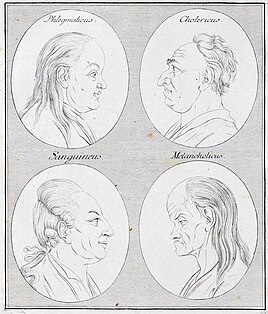Related Research Articles
Psychometrics is a field of study concerned with the theory and technique of psychological measurement. As defined by the US National Council on Measurement in Education (NCME), psychometrics refers to psychological measurement. Generally, it refers to the field in psychology and education that is devoted to testing, measurement, assessment, and related activities.

The Myers–Briggs Type Indicator (MBTI) is an introspective self-report questionnaire indicating differing psychological preferences in how people perceive the world and make decisions.
Psychological testing is the administration of psychological tests. Psychological tests are administered by trained evaluators. A person's responses are evaluated according to carefully prescribed guidelines. Scores are thought to reflect individual differences in the construct the test purports to measure.The science behind psychological testing is psychometrics.
A field of applied statistics of human research surveys, survey methodology studies the sampling of individual units from a population and associated techniques of survey data collection, such as questionnaire construction and methods for improving the number and accuracy of responses to surveys. Survey methodology includes instruments or procedures that ask one or more questions that may or may not be answered.

The Rorschach test is a psychological test in which subjects' perceptions of inkblots are recorded and then analyzed using psychological interpretation, complex algorithms, or both. Some psychologists use this test to examine a person's personality characteristics and emotional functioning. It has been employed to detect underlying thought disorder, especially in cases where patients are reluctant to describe their thinking processes openly. The test is named after its creator, Swiss psychologist Hermann Rorschach. The Rorschach can be thought of as a psychometric examination of pareidolia, the active pattern of perceiving objects, shapes, or scenery as meaningful things to the observer's experience, the most common being faces or other pattern of forms that are not present at the time of the observation. In the 1960s, the Rorschach was the most widely used projective test.
Thematic apperception test (TAT) is a projective psychological test developed during the 1930s by Henry A. Murray and Christiana D. Morgan at Harvard University. Proponents of the technique assert that subjects' responses, in the narratives they make up about ambiguous pictures of people, reveal their underlying motives, concerns, and the way they see the social world. Historically, the test has been among the most widely researched, taught, and used of such techniques.

A personality test is a method of assessing human personality constructs. Most personality assessment instruments are in fact introspective self-report questionnaire measures or reports from life records (L-data) such as rating scales. Attempts to construct actual performance tests of personality have been very limited even though Raymond Cattell with his colleague Frank Warburton compiled a list of over 2000 separate objective tests that could be used in constructing objective personality tests. One exception however, was the Objective-Analytic Test Battery, a performance test designed to quantitatively measure 10 factor-analytically discerned personality trait dimensions. A major problem with both L-data and Q-data methods is that because of item transparency, rating scales and self-report questionnaires are highly susceptible to motivational and response distortion ranging all the way from lack of adequate self-insight to downright dissimulation depending on the reason/motivation for the assessment being undertaken.
In psychology, a projective test is a personality test designed to let a person respond to ambiguous stimuli, presumably revealing hidden emotions and internal conflicts projected by the person into the test. This is sometimes contrasted with a so-called "objective test" / "self-report test", which adopt a "structured" approach as responses are analyzed according to a presumed universal standard, and are limited to the content of the test. The responses to projective tests are content analyzed for meaning rather than being based on presuppositions about meaning, as is the case with objective tests. Projective tests have their origins in psychoanalysis, which argues that humans have conscious and unconscious attitudes and motivations that are beyond or hidden from conscious awareness.

A questionnaire is a research instrument consisting of a series of questions for the purpose of gathering information from respondents. The questionnaire was invented by the Statistical Society of London in 1838.

Raymond Bernard Cattell was a British and American psychologist, known for his psychometric research into intrapersonal psychological structure. His work also explored the basic dimensions of personality and temperament, the range of cognitive abilities, the dynamic dimensions of motivation and emotion, the clinical dimensions of abnormal personality, patterns of group syntality and social behavior, applications of personality research to psychotherapy and learning theory, predictors of creativity and achievement, and many multivariate research methods including the refinement of factor analytic methods for exploring and measuring these domains. Cattell authored, co-authored, or edited almost 60 scholarly books, more than 500 research articles, and over 30 standardized psychometric tests, questionnaires, and rating scales. According to a widely cited ranking, Cattell was the 16th most eminent, 7th most cited in the scientific journal literature, and among the most productive psychologists of the 20th century. He was, however, a controversial figure, due in part to his friendships with and intellectual respect for white supremacists and neo-Nazis.
The implicit-association test (IAT) is a controversial assessment in the field of social psychology intended to detect the strength of a person's subconscious association between mental representations of objects (concepts) in memory. It is commonly applied to assess implicit stereotypes held by test subjects, such as unconsciously associating stereotypically black names with words consistent with black stereotypes. The test's format is highly versatile, and has been used to investigate biases in racial groups, gender, sexuality, age, and religion, as well as assessing self-esteem.

Semantic differential (SD) is a type of a rating scale designed to measure the connotative meaning of objects, events, and concepts. The connotations are used to derive the attitude towards the given object, event or concept.
Personality Assessment Inventory (PAI), developed by Leslie Morey, is a self-report 344-item personality test that assesses a respondent's personality and psychopathology. Each item is a statement about the respondent that the respondent rates with a 4-point scale. It is used in various contexts, including psychotherapy, crisis/evaluation, forensic, personnel selection, pain/medical, and child custody assessment. The test construction strategy for the PAI was primarily deductive and rational. It shows good convergent validity with other personality tests, such as the Minnesota Multiphasic Personality Inventory and the Revised NEO Personality Inventory.
The Rotter Incomplete Sentences Blank is a projective psychological test developed by Julian B. Rotter. It comes in three forms and comprises 40 incomplete sentences usually only 1–2 words long, such as "I regret ..." and "Mostly girls ...". The subject is asked to complete the sentence.
Consensus-based assessment expands on the common practice of consensus decision-making and the theoretical observation that expertise can be closely approximated by large numbers of novices or journeymen. It creates a method for determining measurement standards for very ambiguous domains of knowledge, such as emotional intelligence, politics, religion, values and culture in general. From this perspective, the shared knowledge that forms cultural consensus can be assessed in much the same way as expertise or general intelligence.
The Sixteen Personality Factor Questionnaire (16PF) is a self-report personality test developed over several decades of empirical research by Raymond B. Cattell, Maurice Tatsuoka and Herbert Eber. The 16PF provides a measure of normal personality and can also be used by psychologists, and other mental health professionals, as a clinical instrument to help diagnose psychiatric disorders, and help with prognosis and therapy planning. The 16PF can also provide information relevant to the clinical and counseling process, such as an individual’s capacity for insight, self-esteem, cognitive style, internalization of standards, openness to change, capacity for empathy, level of interpersonal trust, quality of attachments, interpersonal needs, attitude toward authority, reaction toward dynamics of power, frustration tolerance, and coping style. Thus, the 16PF instrument provides clinicians with a normal-range measurement of anxiety, adjustment, emotional stability and behavioral problems. Clinicians can use 16PF results to identify effective strategies for establishing a working alliance, to develop a therapeutic plan, and to select effective therapeutic interventions or modes of treatment. It can also be used within other areas of psychology, such as career and occupational selection.
The Adjective Check List (ACL) is a psychological assessment containing 300 adjectives used to identify common psychological traits. The ACL was constructed by Harrison G. Gough and Alfred B. Heilbrun, Jr. with the goal to assess psychological traits of an individual. The ACL measures 37 scales within 5 categories: modus operandi, need, topical, transactional analysis, and origence-intellectence. To complete the ACL, respondents select the adjectives that they believe describe themselves. Any number of items may be selected from the list of adjectives. In this way, the results are customized to include only those adjectives salient to the individual being assessed. The ACL takes between 10-15 minutes to complete and may be administered to individuals, groups, or used by researchers to describe study participants. The ACL is protected by copyright law, published by Consulting Psychologists Press, and distributed by Mind Garden, Inc.
Individual psychological assessment (IPA) is a tool used by organizations to make decisions on employment. IPA allows employers to evaluate and maintain potential candidates for hiring, promotion, and development by using a series of job analysis instruments such as position analysis questionnaires (PAQ), occupational analysis inventory (OAI), and functional job analysis (FJA). These instruments allow the assessor to develop valid measures of intelligence, personality tests, and a range of other factors as means to determine selection and promotion decisions. Personality and cognitive ability are good predictors of performance. Emotional Intelligence helps individuals navigate through challenging organizational and interpersonal encounters. Since individual differences have a long history in explaining human behavior and the different ways in which individuals respond to similar events and circumstances, these factors allow the organization to determine if an applicant has the competence to effectively and successfully do the work that the job requires. These assessments are administered throughout organizations in different forms, but they share one common goal in the selection process, and that is the right candidate for the job.
The Washington University Sentence Completion Test (WUSCT) is a sentence completion test created by Jane Loevinger, which measures ego development along Loevinger's stages of ego development. The WUSCT is a projective test; a type of psychometric test designed to measure psychic phenomenon by capturing a subject's psychological projection and measuring it in a quantifiable manner. The test has been characterized as a good test for clinical use as it can measure across distinct psychopathologies and help in choosing treatment modalities; to this end, it is used by many clinical psychologists and psychiatrists.
The Vienna Test System (VTS) is a test system for computerized psychological assessments. With it, digital psychological tests can be administered and it provides automatic and comprehensive scoring. The system includes classical questionnaires and also tests that can only be scored by a computer, such as time-sensitive test presentation, multi-media presentation, adaptive tests, psychomotricity, combinations of tests for specific purposes and differentiated scoring of individual responses.
References
- ↑ Putthiwanit, C. (2012) Investigating consumer insight by using completion techniques: A pilot study of a motorcycle accessory shop in Thailand. International Review of Management and Marketing, 2, 92-8.
- 1 2 Rhode, A.R. (1957) The Sentence Completion Method. New York: The Ronald Press 1957; Lah, M.I. (1989). Sentence Completion Tests. In C.S. Newmark (Ed.), Major psychological assessment instruments, Vol II (pp 133-163). Boston: Allyn and Bacon.
- ↑ Holaday, M., Smith, D.A. & Sherry, A. (2000). Sentence completion tests: A review of the literature and results of a survey of members of the society for personality assessment. Journal of Personality Assessment, 74, 371-383.; Lubin, B., Larsen, R.M. & Matarazzo, J.D. (1984). Patterns of psychological test usage in United States: 1935-1982. American Psychologist, 39, 451-454.
- 1 2 3 4 Lawrence C. Soley & Aaron Lee Smith (2008). Projective Techniques for Social Science and Business Research. Milwaukee: The Southshore Press.
- ↑ Gregory, J. Robert., Psychological Testing: History, Principles and App.ications. Ed. 5. Wheaton College. Wheaton, Illinois. Peterson: 2007